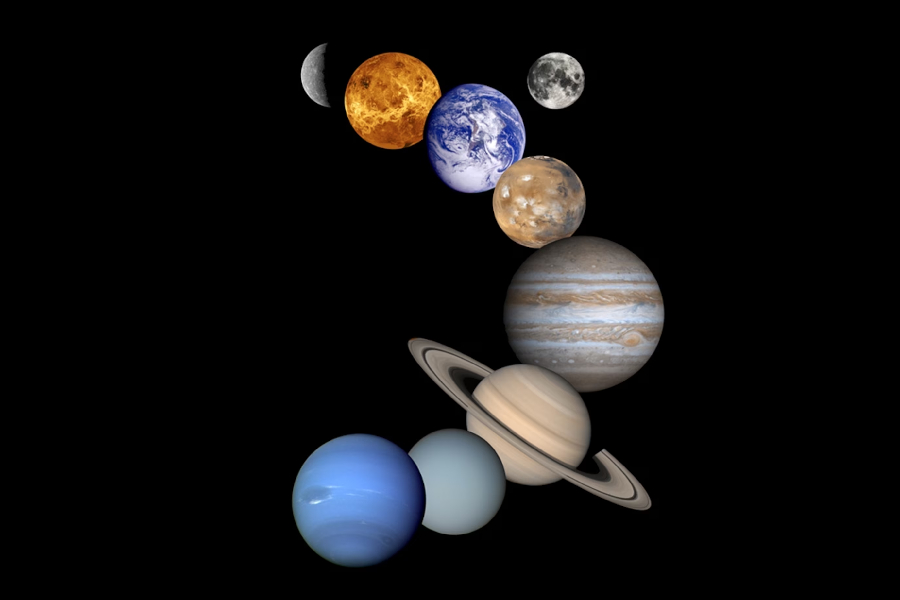Our solar system formed from a swirling cloud of ancient gas and debris over 4 billion years ago. Slowly, particles of dust collected into larger clumps orbiting a nascent Sun. Some accumulations grew massive enough under gravity to become spheres known as planets. But, not all planets evolved identically in their characteristics and compositions on this journey from solar nebulae to worlds as we observe them today. That’s why there is a visible difference between Terrestrial and Jovian planets.
Join us on a comparative tour of the solar system to discover what sets quirky Mercury, hellish Venus, life-bearing Earth, and rusty Mars fundamentally apart. We will compare these planets to the swirling gas behemoths Jupiter, ringed Saturn, tilted Uranus, and Neptune.

Difference Between Terrestrial and Jovian Planets
The distinctions between Terrestrial and Jovian planets revolve around size, composition, and atmospheric nature. Terrestrial planets, exemplified by Earth, are characterized by small, rocky structures and thin atmospheres.
In contrast, Jovian planets, such as Jupiter and Saturn, showcase immense sizes and thick atmospheres dominated by hydrogen and helium. As we embark on the journey into definitions, Terrestrial realms involve rocky surfaces and are in close proximity to the Sun. But let’s explore the difference between Terrestiral and Jovian planets in-depth.
Definition of Terrestrial Planets
Terrestrial planets, constituting a distinctive category in our solar system, are characterized by specific traits that set them apart from their celestial counterparts. One defining feature is their relatively small size compared to the larger gas giants.
These planets, including Earth, exhibit solid, rocky surfaces, a key distinction from the gaseous giants with their lack of defined surfaces. The emphasis on solid ground serves as a fundamental characteristic, contributing to the unique dynamics of terrestrial realms.
The individual members—Mercury, Venus, Earth, and Mars—exhibit diverse compositions, contributing to the unique characteristics within this planetary category.
Definition of Jovian Planets
The Jovian planets are Jupiter, Saturn, Uranus, and Neptune – the massive gas giants of our solar system. Much larger than Earth, they lack solid surfaces and are made up predominantly of swirling hydrogen, helium, and other gasses surrounding dense cores.
Jovian planets have incredibly thick atmospheres and powerful storms, like Jupiter’s Great Red Spot and Saturn’s beautiful icy rings.
More distant Uranus and Neptune contain larger amounts of methane, ammonia, and water. The immense Jovian planets showcase a diversity of giant worlds and dynamic atmospheres in our outer solar system.
Characteristics of Terrestrial Planets
Terrestrial planets are the compact, rocky inner worlds of the solar system with solid surfaces and thin atmospheres, which, as we said, orbit close to the Sun. Compared to the Jovian planets, these rocky surfaces have dense metal cores surrounded by rocky mantles and crusts. Terrestrial planets exhibit diverse surface features, including mountains, valleys, plains, and impact craters. Geological activity, such as volcanism and tectonics, is common on these planets.
The planets referred to as Terrestrial are Mercury, Venus, Mars, and Earth.
Terrestrial planets have thinner atmospheres compared to gas giants. Earth’s atmosphere, for example, contains nitrogen, oxygen, and trace gases that support life. The Earth is also ideally situated to maintain liquid water oceans and a protective atmosphere suitable for life. Venus is too hot for life due to its dense carbon dioxide atmosphere trapping heat. Mars is a cold, dry planet that once had water and more atmospheric density.
Regarding the moons, we have to say that terrestrial planets have fewer or no moons at all. Earth has one moon, while Mars has two small moons.
Characteristics of Jovian Planets
The Jovian planets Jupiter, Saturn, Uranus, and Neptune are the behemoths of the solar system, characterized by their massive size, hydrogen-helium atmospheres, and lack of solid surfaces. When compared with Terrestrial planets, we have to say that these planets are quite large.
Their thick atmospheres gradually transition into liquid and solid layers under extreme pressures. Jovian planets host raging storms like Jupiter’s Great Red Spot. The Jovian planets have unique moons showing geologic activity. Their immense scale and dynamic atmospheres distinguish Jovian planets as true wonders of the outer solar system.
Conclusion
In exploring the diversity of planets in our solar system, we have seen how terrestrial and Jovian planets differ remarkably in their fundamental nature and attributes. Terrestrial planets are smaller, rocky worlds clustered near the Sun, while Jovian planets are gaseous giants that dwell in the outer solar system.
This article has highlighted the stark difference between Terrestrial and Jovian planets to help you gain a deeper appreciation of what sets rocky inner planets apart from the cloud-enshrouded leviathans of the outer solar system.
